Resources
Useful articles in 'Primary History'
|
Each section of this unit begins by highlighting articles based on the current National Curriculum, and is followed by earlier pieces that are still worth reading. Please note that while the core advice is still relevant, articles from editions published prior to Primary History 66 will be based on the old National Curriculum. |
1. Historical sources
2. Classroom museums
3. Display
4. Drama/role play
5. Historical fiction
6. IT/digital
7. Museums/sites
8. Oral/talk
9. Out of classroom
10. Pictorial
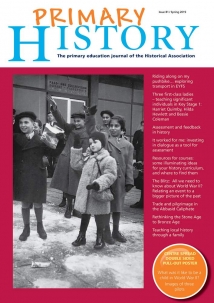
1. Historical sources
- Tim Lomas, ‘Using some more unusual sources in the primary classroom’, PH 95, autumn 2023
- Summer Resource 2021: Using historical sources with primary pupils - covers why use sources, key ideas, problems using sources, types of questions, how can I help pupils read written historical sources.
- Helen Crawford and Rebecca Iddon, ‘Resources for courses: some illuminating ideas for your history curriculum and where to find them’ PH 81, spring 2019
- Tim Lomas, ‘Resourcing primary history: how to avoid going for any old thing’ PH 72, spring 2016
Also:
- Mary Mills, ‘What was it like to live here in the Past? Resourcing the Local Study – an approach based on local buildings, archives and the world wide web’ PH 40, summer 2005. Case study and resources using Wolsingham
- Diana Knapp, ‘A Good Place for an Investigation: using sources to develop a local history project’, PH 16, June 1997.
Archives and Written Sources:
- Silke Bakenhus, ‘Time travel to the Early Modern period with teaching materials based on sources from the Prize Papers Project’ PH 97, summer 2024
- Clare Lally, ‘Using inventories in Key Stage 2 history’, PH 95, autumn 2023
- Steven Kenyon, ‘Teaching black British history through local archives’, PH 94, summer 2023
- Tim Lomas, ‘Back to basics: using maps in primary history’, PH 91, summer 2022.
- Anthony Barlow, ‘Ukraine, children and schools’ PH 90, spring 2022.
- Helen Crawford, ‘Ten texts for the Platinum Jubilee’ PH, 90, spring 2022.
- Tim Lomas, ‘Preparing for the release of the 1921 census: how can we make effective use of the census in the primary history classroom’, PH 89, autumn 2022.
- Alf Wilkinson, ‘Using trade directories – reconstructing life 100 years ago – A case study from Heckington, Lincolnshire’ PH 88, summer 2021
- Clare Horrie, ‘Using different sources to bring a topic to life: The Rebecca Riots’, PH 85, Summer 2020.
- Sue Temple and Debbie Graham, ‘Making the most of a census’ PH 83, autumn 2019
- Sarah Leach, ‘Teaching about my school in the past using original sources or why would I want those old books in my classroom’ PH 73, summer 2016
- Alf Wilkinson, ‘What can you do with a Victorian Trade Directory..? PH 72, spring 2016
- Anna Carter, ‘What your local Archive Service can offer to schools’ PH 70, summer 2015
- Jon Nichol, ‘Place-names and the National Curriculum for History’ PH 68, summer 2014
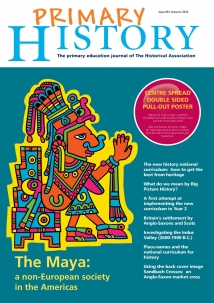
Also:
- Jo Barkham, ‘Local history and literacy using written (and other) sources’ PH 64, summer 2013
- Jon Nichol, ‘History is literacy: doing history with written and printed sources’ PH 64, summer 2013.
- Alf Wilkinson, ‘Effectively using the census in the classroom’ PH 62, autumn 2012.
- Jane Shuter, ‘Popular History: Using the Media’ PH 57, spring 2011.
- Jo Barkham, ‘Local History: young children using written, printed and multi-modal sources’ PH 56, autumn 2010.
- John Fines, ‘Reading the Past: Written and printed sources’ PH 56, autumn 2010.
- John Fines, ‘Doing Local History through Maps and Drama’, PH 55, summer 2010.
- Alf Wilkinson, ‘A local history toolkit’, PH 55 summer 2010. Includes valuable sources.
- Penelope Harnett, ‘Using Diaries to stimulate children’s understanding of the past’, PH 43, spring 2006.
- Fiona Collins, ‘Time Past: Working with Historical Picture Books’, PH 43, summer 2006.
- Pat Hoodless, ‘History and written sources’ PH 37, summer 2004.
- Mary Mills, ‘Accessing Archive Sources’, PH 34, spring 2003.
- Jacqui Halewood, ‘Using School Logbooks – Bishop Graham Memorial Ragged School Chester’, PH 24, January 2000, Includes resource.
- Jacqui Halewood, ‘A Treasure Trove of Local History – How to use your Local Record Office’, PH 24, January 2000.
- Beryl Kingsbury, ‘Picture Books for Teaching History’, PH 20, October 1998.
Archaeology:
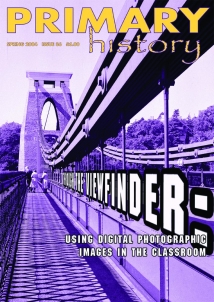
- Ilona Aronovsky and Akshyeta Suryanarayan, ‘Bringing an archaeologist into the classroom’, PH 91, summer 2022.
- Ilona Aronovsky, ‘Think like an archaeologist! Investigating Indus Valley artefacts in the primary classroom’, PH 91, summer 2022.
- Chris Kolonko, ‘Home Front Legacy 1914-1918: an opportunity for your school to join an archaeological journey discovering the First World War Home Front’ PH 77, autumn 2017.
Also:
- Marion Green, ‘Dig It: Literacy, ICT, Archaeology and History’ PH 56, autumn 2010. A Kent Primary School initiative
- Margaret Bunyard, ‘School Children work as Archaeologists’ PH 51, spring 2009.
- Jacqui Dean, ‘Nuffield Primary History and Classroom Archaeology’, PH 51, spring 2009.
- Hilary Cooper, ‘Children’s Thinking in Archaeology’, PH 51, spring 2009.
- Cathy McIlroy, ‘Archaeology: A View from the Classroom’, PH 51, spring 2009.
- Julian Richards, ‘Bringing the Past to Life’ (archaeology) PH 51, spring 2009
- Don Henson, ‘The true end of archaeology’ PH 51, spring 2009.
- Tim Lomas, ‘Archaeology use in an area where there are few remains’ (Co-ordinators dilemma), PH 51 spring 2009.
- Jon Nichol, ‘Doing Archaeology with Children’, PH 51, spring 2009.
- Nicky Milsted, ‘Young Archaeologist of the Year Award: Don’t just dig things up Values and virtues of Archaeology in the Primary School’ PH 43, spring 2006. Contains ideas for using archaeology in primary schools.
- Don Henson, ‘History and Archaeology’, PH 36, spring 2004.
- Andy Bowles and Dave Weldrake, ‘Archaeology – An Approach to Teaching History at Key Stage 2’, PH 29, October 2002.
Artefacts:
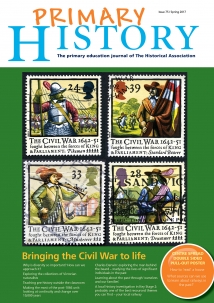
- James P. Bowen, ‘In grateful memory of former scholars of this school: school war memorials as the subject for enquiry-based learning’ PH 92, autumn 2022
- Kate Rigby, ‘Back to basics: using artefacts in the classroom’, PH 90, spring 2022.
- Sophie Jones, ‘Malachite Urn’, PH 86 Autumn 2020. Image and teaching ideas
- Izzy Bartley, ‘Painted wooden police truncheon’ PH 82, summer 2019. Image and teaching ideas.
- Jules Kensett Wooding, ‘Lest We Forget: First World War objects of Remembrance’ PH 81, spring 2019. Image and teaching ideas.
- Matthew Sossick, ‘The moustache cup’ PH 79, summer 2018. Image and teaching ideas.
- Jules Wooding, ‘Siege coins of the English Civil War’. . PH 78, spring 2018. Image and teaching ideas.
- Jules Wooding, ‘The workshop of the world: industrial collections in local museums – the Tyne Map’ PH 77, autumn 2017. Image and teaching ideas
- Jules Wooding, ‘Exploring the collection of Victorian naturalists’ PH 75, spring 2017. Image and teaching ideas.
- Jules Wooding, ‘Using shoes as a historical source’ PH 73, summer 2016. Image and teaching ideas.
- Jules Wooding, ‘Private David Johnston’s First World War Hymn Book’ PH 72 Spring 2016. Image and teaching ideas.
Also:
- Grant Bage, ‘History, Artefacts and Storytelling in the 2011 Primary Curriculum’, PH 54, spring 2010. Making history accessible through stories of artefacts
- Yosanne Vella, ‘Extending primary children’s thinking through the use of artefacts’, PH 54, spring 2010.
- The British Museum and the BBC, ‘A History of the World: 100 Objects that tell a Story’, PH 54, spring 2010.
- John Fines, ‘Doing history with objects’, PH 54, spring 2010.
- Yosanne Vella, ‘Artefacts in history education’ PH 54, spring 2010.
- Peter Hammond, ‘A Load of Rubbish: Using Victorian Throwaways in the Classroom’, PH 36, spring 2004.
- Jayne Woodhouse, ‘Collecting and using artefacts’ (Co-ordinators dilemma), PH 35, autumn 2003.
- Dean Smart, ‘The Strange Power of Hats: Using Artefacts and Role Play in Cross-Phase, Cross Curricular and Community Partnership Work’, PH 28, May 2001. The specific example of hats as a teaching aid.
2. Classroom Museums
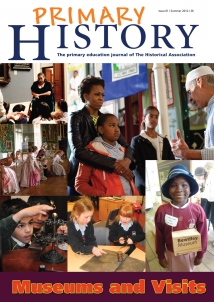
Also:
- James Searjeant, ‘We built a museum. What does your school resource room look like?’ PH 89, autumn 2022.
- Jennie Wilkie, ‘How to make a Toy Museum’ PH 88, summer 2021
- Gloria Sole, ‘A Museum in the Classroom: Learning history from objects’ PH 61, summer 2012.
- Jane Zanzottera, ‘Bringing the museum into your classroom – creating a school museum’ PH 61, summer 2012.
- Ray Verrier, ‘A classroom museum’ PH 45, spring 2007.
3. Display
- Meryl Goldsmith, ‘Creating effective history displays’ PH 92, autumn 2022.
4. Drama/Role Play
Also:
- Nuffield Primary History Project, ‘Drama and Role Play’ PH 60, spring 2012. Case study of The Tempest
- Hilary Cooper, ‘Learning to engage with documents through Role Play’ PH 56, autumn 2010.
- John Fines, ‘Doing Local History through Maps and Drama’, PH 55, summer 2010.
- Cheryl Dodwell, ‘Drama and Story telling: Creative approaches for teaching historical, geographical and social understanding’ PH 53, autumn 2009.
- Dorothy Heathcote, ‘Means and Ends: History, Drama and Education for Life’ (In My View), PH 48, spring 2008.
- John Fines, ‘Working through Drama’ PH 48, spring 2008.
- Ray Verrier, ‘Drama: Choosing an Approach’, PH 48, spring 2008.
- Peter Vass, ‘Drama and History: A Theory for Learning’, PH 48, spring 2008.
- Viv Wilson and Jayne Woodhouse, ‘History through Drama. A Teachers Guide – Revisited’, PH 48, spring 2008.
- Hugh Turner, ‘Case Study 1: Getting Started with Drama: From Freeze Frame to Performance: The Plague and the Village of Eyam’, PH 48, spring 2008.
- Dani Compton, ‘Case Study 2: How much Drama? How much History? Unpicking the Learning Potential in Creative Approaches to studying World War 2’, PH 48, spring 2008.
- Zara d’Archambaud, ‘Case Study 3: Researching History: Time Travellers and Role Players’, PH 48, spring 2008.
- Richard Knights, ‘Samantha’s Dream: Watch making in Victorian Prescot’, PH 42, spring 2006. Local history using drama and buildings.
- Dean Smart, ‘The Strange Power of Hats: Using Artefacts and Role Play in Cross-Phase, Cross Curricular and Community Partnership Work’, PH 28, May 2001. The specific example of hats as a teaching aid.
5. Historical Fiction
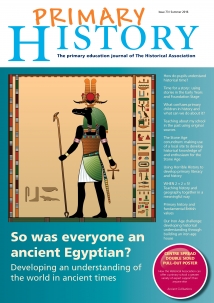
- Tom Palmer, ‘Four objects in search of a story: why artefacts matters in history’, PH 98, autumn 2024.
- Primary History summer guide 2020: Historical fiction
- Alf Wilkinson, ‘Historical fiction: it's all made up, isn't it?’ PH 85, Summer 2020
- Jennifer Donovan, ‘Using Horrible History to develop primary literacy and history’ PH 73, summer 2016
- Alf Wilkinson, ‘Using myths and legends in the classroom’ PH 72, spring 2016
Also:
- Nuffield Primary History Project, ‘Historical fiction and story: the informed imagination’ PH 60, spring 2012. Includes case study of a Tudor feast
- Hilary Cooper, ‘Constructivist Chronology and Horrible Histories’ PH 59, autumn 2011. Using Horrible Histories to explore time.
- Ann Cowling, ‘Using Classic Fiction to support the Study of Childhood in Victorian Times’ PH 56, autumn 2010.
- Russell Jones, ‘Using Children’s literature to look at bias and stereotyping’ (In My View), PH 41, autumn 2005.
- Dave Martin, ‘Using Historical Fiction in the Classroom’, PH 41, autumn 2005.
- Darius Jackson, Alison Humphries and Paul Bracey, ‘From the Frying Pan into the Fire? Escaping the London Blitz: Exploring the Use of Historical Fiction to Support Historical Learning’, PH 41, autumn 2005.
- Dave Martin, ‘Why Should We Use Historical Fiction to Teach English and History’, PH 22, April 1999.
- Neil Curtis, Janet Goolnik and Kate Hopkins, ‘Historical fiction and museum objects’ PH 16, June 1997. Based at Marischal Museum and using the novel, The Desperate Journey..
6. IT/Digital
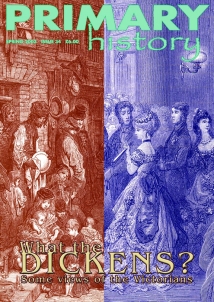
- Simon Lee and Ailsa Fidler, ‘Artificial intelligence (AI) in primary history – take CARE’, PH 98, autumn 2024
- Glen Carter, ‘Using apps in the history curriculum’ PH 82, summer 2019
Also:
- Tim Lomas, ‘Using ICT: Coordinator role’ (Co-ordinator concerns) PH 62, autumn 2012
- Michael Maddison, ‘Using ICT to develop pupils’ historical knowledge, understanding and thinking: the view from Ofsted’ PH 62, autumn 2012.
- Jerome Freeman, ‘The digital revolution’ PH 62, autumn 2012.
- Ben Walsh, ‘History, ICT and the digital age’ PH 62, autumn 2012.
- Cathie McIlroy, ‘Historical information and the local community: using ICT’ A view from the classroom’ PH 62, autumn 2012.
- Susan Edgar, ‘Primary pedagogy and interactive Powerpoint’ PH 62, autumn 2012.
- Stuart Tiffany and My Learning Website, ‘History and the digital age: the interactive whiteboard or smartboard’ PH 62, autumn 2012.
- Nicholas Garrick and Dave Hall, ‘Bring on the iPad revolution’ PH 62, autumn 2012.
- Barbara Sands, ‘Hit the net’ PH 62 autumn 2012. Teaching 1930s Britain with Year 6 digitally.
- Matthew Sossick, ‘Using ICT to support historical learning with pupils who have special educational needs – Tudor videos’ PH 62, autumn 2012.
- Laura Austin, ‘ICT and Local History: The Bolham Queen Elizabeth II Golden Jubilee Project 1952-2002’ PH 55, summer 2010. A Devon primary schools involvement in a local history project.
- Mary Mills ‘Teaching History through Photographs in the Internet and Digital Age’, PH 49, summer 2008.
- Mary Mills, ‘Through the Viewfinder. Using digital photographic images in the classroom’, PH 36, spring 2004.
- Ben Walsh, ‘Is there a place for the computer in Primary History?’ PH 34, spring 2003. A little outdated but some good relevant ideas.
- Ruth Noall, ‘How can the Use of Spreadsheets enhance Children’s Learning in History: A Case Study’, PH 26, October 2000.
- Lez Smart, ‘Any Place for a Database in the Teaching and Learning of History at KS1’, PH 23, October 1999.
7. Museums/Sites
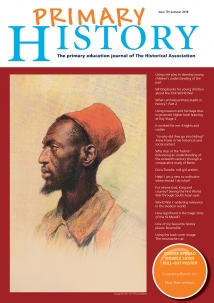
- Susie Townsend, ‘Making the most of a visit to the Museum of London Docklands’, PH 94, summer 2023
- Rosanna Evans, ‘Instead of mummies made with loo roll: how museum collections make ancient Egypt, and the people who lived there, real’ PH 91, summer 2022.
- Mary Kinoultie and Clare Barnes, ‘Using museum and heritage sites to promote higher-level learning at Key Stage 2’ PH 79, summer 2018. Focus on Mary Rose.
Also:
- Cara Williams, ‘V&A Schools: SEN Programme: multi-sensory exploration of historical objects from around the world’ PH 65, autumn 2013
- Janice Welch, ‘Creativity in teaching and learning at the Geffrye Museum’ PH 63, spring 2013.
- Penelope Harnett, Greg Davies, Steve Baxter and Robbie Keast, ‘Creative approaches to learning about the Bristol Blitz’ PH 63, spring 2013.
- Hilary Ferries, ‘Museums, schools and creativity: how learning can be enhanced’ PH 63, spring 2013.
- Jules Wooding, ‘Its more than just gluing and sticking…creativity in museums’ PH 63, spring 2013.
- Jane Shuter, ‘The British Museum: Creative ICT for Kids’ PH 62, autumn 2012.
- Jerome Freeman, ‘Visits and Museums’ PH 61, summer 2012.
- Sarah Codrington, ‘Museums and visits: Nuffield Primary History exemplar lessons’ PH 61, summer 2012.
- Clare Coleman and Peter Vass, ‘They do loves the mummies….making use of outstanding resources in the Ashmolean Museum’ PH 61, summer 2012.
- My Learning website, Andy Hellon and Esther Amis-Hughes, ‘My Learning: Bringing History to Life’ PH 61, summer 2012. Museums in Yorkshire.
- Barbara Sands, ‘All hands on deck’ PH 61, summer 2012. Using SS Great Britain.
- Emily Phipps-Morgan, ‘Bristol Blitz: Writing in an Interactive Environment’ PH 61, summer 2012.
- Kate Morgan Clare, ‘World War II evacuation project: A living history experience’ PH 61, summer 2012.
- Susan Edgar, ‘Using museums, libraries and art galleries: keeping up the momentum in changing times: lessons for sustainability from the experiences of early primary student teachers’ PH 61, summer 2012.
- Natalie Wallace, ‘A Living Timeline: Getting Knebworth House’s Visitors to understand where the distant past is’ PH 59, autumn 2011.
- Sue Temple, ‘Introducing teachers to local history: The Furshill Workhouse Project’ PH 55, summer 2010. Includes various sources including oral and written history.
- Beverley Forrest, ‘Saltaire: Planning for an Effective Learning Experience on a Living Site’, PH 55, summer 2010.
- Helen Horler, ‘Artefact handling at Brunel’s SS Great Britain’ PH 54, spring 2010.
- Eleanor Markland, ‘Doing History with Objects: A Museums Role’, PH 54, spring 2010.
- Laura Arends, ‘St Paul’s Cathedral: Engaging with an iconic building’, PH 52, summer 2009.
- Scott Harrison and Richard Woff, ‘Using Museums and Artefacts’ PH 37, summer 2004. Based on Ofsted reports.
- Rick Weights, ‘Hands On Archaeology: A Case Study: Visiting the Archaeological Resource Centre (ARC) in York’, PH 35, Autumn 2003.
- Jacki Winstanley and Karen Teasdale, ‘In the Footsetps of our Ancestors: Beamish – a unique educational experience’, PH 35, autumn 2003.
- Karin Doull, ‘Using a Local Museum: Fulham Palace, the Hidden Jewel of West London’, PH 35, autumn 2003.
- Jo Peat, ‘A Quick Guide to Museums and Galleries on the Internet’, PH 35, autumn 2003.
- Jackie Winstanley and Karen Teasdale, ‘In the Footsteps of our Ancestors: Beamish: A unique educational experience’, PH 35, autumn 2003.
- Karin Doull, ‘Using a Local Museum: Fulham palace, the Hidden Jewel of West London’ PH 35, autumn 2003.
- ‘Tate Britain’, PH 33, winter 2003. Includes resources and activities.
- Fiona Dodwell, ‘The Jill Grey Collection and Hitchin British Schools’, PH 27, January 2001. History of education and childhood. Includes resources.
- Susanna Wood, ‘Rhyd-Y-Car Cottages at St Fagans Museum of Welsh Life’, PH 26, October 2000.
- Richard Woff, ‘Beyond the Classroom Walls: Museums and Primary History’, PH 24, January 2000.
- Jo Lawrie, ‘Sevington School – a Unique History Resource’, PH 19, teaching about education through a Victorian School Museum.
- Neil Curtis, Janet Goolnik and Kate Hopkins, ‘Historical fiction and museum objects’ PH 16, June 1997. Based at Marischal Museum and using the novel, The Desperate Journey.
8. Oral/Talk
- Kelly Bridle, ‘The role of oracy in primary history: improving understanding of links across historical time’, PH 98, autumn 2024
- Catriona Ni Cassaithe and Anne Marie Kavanagh, ‘Using Indigenous and traditional stories to teach for climate and ecological action’, PH 96, spring 2024.
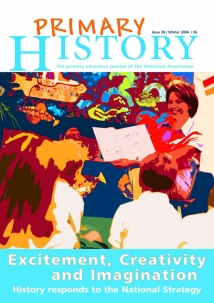
Also:
- Alastair Daniel, ‘Storytelling the past: The role of story and storytelling in primary history’ PH 86, autumn 2020
- Grant Bage, ‘Doing History: Story Telling. How can we imagine the Past?’, PH 57, spring 2011.
- Mick Anderson, ‘Oral History: A Source of Primary Evidence for Children in the Primary Classroom’, PH 55, summer 2010.
- Jacquie Dean, ‘The Leeds Community History Project’, PH 50, autumn 2008. Linking schools and the older community.
- Yosanne Velle, ‘Promoting Talk during History Lessons’, PH 40, summer 2005.
- Hilary Claire, ‘Oral History: A Powerful Tool or a Double Edged Sword’, PH 38, winter 2004.
- Allan Redfern, ‘Oral History in primary Schools’, PH 23, October 1999.
- Jill Watson and Penelope Harnett, ‘What was it like when you were at school?’, PH 15, February 1997. Planning an oral history project.
9. Out of Classroom
- Paul Bracey, ‘Opportunities for making use of your local park’ PH 97, summer 2024
- Alf Wilkinson, ‘Artefacts in the neighbourhood’ PH 92, autumn 2022
- Gillian Sykes, ‘Emerging historians in the outdoors’ PH 82, summer 2019
- Richard Harris and Helen Bilton, ‘Strange goings-on: exploring the benefits of learning history through outdoor pedagogy – a case study for Year 5’ PH 80, autumn 2018
- Bev Forrest, ‘Stories in the Stones: using cemeteries as a local history resource’ PH 69, spring 2015
- Kate Hickmott and Helen Chiasson, ‘The New History National Curriculum: how to get the best from heritage’ PH 68, autumn 2014 Includes case studies.
- Ruth Cavender, ‘War memorial as a local history resource’ PH 67, summer 2014. Includes case study and teaching ideas for Westonzoyland War Memorial.
- Hilary Cooper, ‘Churches as a local historical source’ PH 66, spring 2014.
Also:
- Sue Temple, ‘The history on your doorstep: using archives creatively’ PH 63, spring 2013
- Cathie McIlroy, ‘Site visits: a view from the classroom’ PH 61, summer 2012.
- John Fines, ‘Using sites and the environment’ PH 61, summer 2012.
- Sue Temple, ‘The History Around Us: Local History’ PH 57, spring 2011.
- Nuffield Primary History Project, ‘Local History Fieldwork: Top Ten Pointers for Success’. PH 55, summer 2010.
- Sue Temple, ‘Using local buildings’, PH 52, summer 2009.
- Carol Musztacs, ‘Let us think of tomorrow’s past: A living history project in a local community – the Kelloe Community Project’, PH 52, summer 2009. Ex Durham mining village.
- Pat Hoodless, ‘History in the Urban Environment’, PH 52, summer 2009.
- Mike Corbishley, ‘Our Heritage: Use it or Lose it’, PH 51, spring 2009.
- Peter Vass, ‘Dealing with the Dead: Identity and Community – Monuments, Memorials and Local History’, PH 46, summer 2007.
- Richard Knights, ‘Samantha’s Dream: Watch making in Victorian Prescot’, PH 42, spring 2006. Local history using drama and buildings.
- Peter Vass, ‘Piecing Together the Puzzle’ PH 39, spring 2005. Ideas related to using historical sites.
- Tim Lomas, ‘Effective use of field visits’ PH 32, Autumn 2002. Co-ordinators dilemma about using field visits effectively to develop history.
- Tina Cockett, ‘Helping Schools Discover Historic Churches’, PH 30, January 2002.
- Gordon Guest, ‘Looking at Buildings as a Source for Developing Historical Enquiries’, PH 28, May 2001.
- Laurel Tilbury and Jennie Fordham, ‘Don’t forget Key Skills’, PH 27, January 2001. Largely related to educational visits.
10. Pictorial
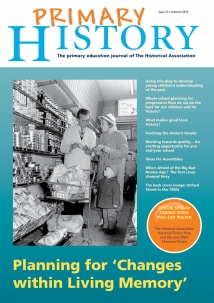
- Tim Lomas, ‘Back to basics: using maps in primary history’, PH 91, summer 2022.
- Matthew Sossick, ‘Using photographic evidence to explore the impact of the Berlin Wall’ PH 90, spring 2022.
- Nina Sprigge, ‘Sources for the Great Fire of London and its context’ PH 88, summer 2021
- Tim Lomas, ‘How can old advertisements be used in the primary classroom?’ PH 80, autumn 2018
- Alf Wilkinson, ‘What can you do with an old postcard?’ PH 78, spring 2018.
- Helen Maddison, ‘Oxford Street in the 1960s’ Image plus teaching ideas. PH 71, autumn 2015
Also:
- Jane Card, ‘Pointing the view: helping pupils to view historical film critically’ PH 62, autumn 2012. Case study of using a public information film
- Jane Card, ‘Visual Literacy: Look, talk, write – using a picture to extend vocabulary’ PH 60, spring 2012.
- Jane Card, ‘Scene Shifting: Using Visuals for Chronology’ PH 59, autumn 2011.
- Jane Card, ‘Doing History: Pupils as Apprentice Historians (3) – the Importance of Teaching with Visual Sources’ PH 57, spring 2011.
- Jane Card, ‘Printed Pictures with Text: Using cartoons as historical evidence’ PH 56, autumn 2010.
- Jane Card, ‘Branching out: local railway history using visual sources’, PH 55, summer 2010.
- Jane Card, ‘Artefacts and Art Facts: Images and Sir Francis Drake’, PH 54, spring 2010.
- Editorial, ‘Visual Literacy and Learning through Pictures and Images’, PH 49, summer 2008.
- John Fines, ‘Using Pictures’ PH 49, summer 2008.
- Bob Burden, ‘Using Feature Films as a means of enhancing history teaching in the primary school’, PH 49, summer 2008.
- Alan Hodkinson, ‘Using the Visual Image in Primary Schools: A beginners Guide’, PH 49, summer 2008
- Jacquie Dean, ‘The Power of the Visual Image in Learning: The Nuffield Primary History Approach’, PH 49, summer 2008.
- Jacquie Dean, ‘Pictorial Recording’, PH 49, summer 2008.
- Hilary Cooper, ‘Case Study 3: Every Picture tells a Story: Sage Comme une Image’, PH 49, summer 2008. Using images to teach Victorian Britain.
- Penelope Harnett, ‘Case Study 4: Did they always draw things on the pots they made? Children’s questions about historical pictures’, PH 49, summer 2008.
- Mary Mills, ‘All Aboard the Skylark: Images and Ideas got teaching Seaside’ PH 42, spring 2006. Plenty of resources.
- Alan Hodkinson, ‘Using Photographs as Sources of Evidence’, PH 38, winter 2004.
- Anna Disney and Peter Hammond, ‘Using Historical Maps in the Primary Classroom’, PH 32, autumn 2003.
- Cary Bazalgette, ‘Refined, High-Class and Thrilling Entertainment’, PH 29, October 2002. Using film in primary history teaching.
- Alan Hodkinson, ‘A Practical Guide to using Photographic Evidence in the Primary Classroom’, PH 16, June 1997.


